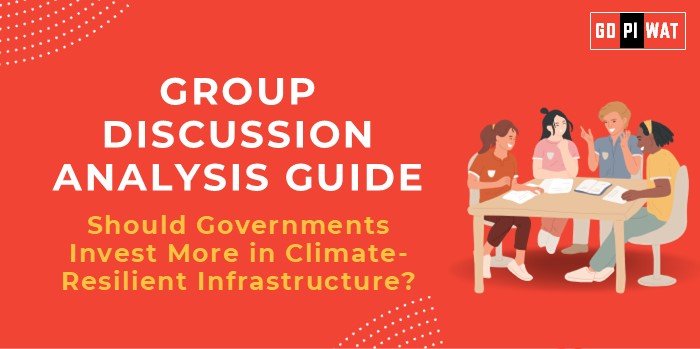📋 Group Discussion Analysis Guide: Should Governments Invest More in Climate-Resilient Infrastructure?
🌍 Introduction to the Topic
Opening Context: With climate change triggering severe weather events worldwide, the need for resilient infrastructure has become a cornerstone for sustainable development. Governments are increasingly tasked to safeguard citizens and economies against these disruptions.
Topic Background: The conversation around climate-resilient infrastructure gained momentum with the Paris Agreement in 2015, emphasizing adaptation as much as mitigation. Recent disasters like wildfires in California or floods in Pakistan underline the urgency for such investments.
📊 Quick Facts and Key Statistics
- Global Disaster Costs: $275 billion in damages (2022) – highlights escalating economic impacts of climate events.
- Infrastructure Vulnerability: 70% of global infrastructure at risk from extreme weather (World Bank).
- Government Spending: $1 invested in resilience saves $6 in recovery (UNDRR).
- Urban Risks: 60% of urban areas expected to face climate-related threats by 2050 (UN-Habitat).
👥 Stakeholders and Their Roles
- Governments: Policy creation, funding, and execution of resilience projects.
- Private Sector: Innovation in sustainable construction and financing public-private partnerships.
- NGOs/Communities: Advocating and implementing local adaptation strategies.
- International Bodies: Setting global standards and providing technical support (e.g., UN, World Bank).
✨ Achievements and Challenges
- Achievements:
- Japan’s earthquake-resistant infrastructure significantly reduces casualties.
- Netherlands’ Delta Works—a global benchmark in flood resilience.
- India’s Cyclone Early Warning Systems: Saved thousands during recent storms.
- Challenges:
- Funding Gaps: $90 trillion needed for resilient infrastructure by 2030.
- Urban Bias: Rural areas often neglected in resilience planning.
- Global Comparisons: While countries like Japan excel, developing nations face severe resource constraints.
- Case Study: Bangladesh’s floating schools and homes—a cost-effective local adaptation model.
🔄 Structured Arguments for Discussion
- Supporting Stance: “Investments in climate-resilient infrastructure save lives, reduce economic losses, and ensure long-term sustainability.”
- Opposing Stance: “The focus on infrastructure overshadows urgent mitigation efforts like reducing emissions.”
- Balanced Perspective: “While resilience investments are crucial, they should complement emission reduction policies.”
✅ Effective Discussion Approaches
- Opening Approaches:
- Data-Driven Start: “With $275 billion in damages from disasters last year, it’s evident that resilience investments are non-negotiable.”
- Case Study Highlight: “The Netherlands demonstrates how resilience can safeguard a nation.”
- Counter-Argument Handling:
- Example: “Even though funds are limited, prioritizing resilience prevents costlier recoveries.”
📈 Strategic Analysis of Strengths and Weaknesses
- Strengths: Proven cost-effectiveness of resilience investments, enhanced disaster response capabilities.
- Weaknesses: High initial costs, lack of technical expertise in developing nations.
- Opportunities: Leveraging green bonds for funding, scaling innovative designs like permeable roads.
- Threats: Increasing climate unpredictability, political resistance due to upfront costs.
🎓 Connecting with B-School Applications
- Real-World Applications:
- Projects on sustainable finance.
- Innovations in green technologies and disaster management.
- Sample Interview Questions:
- “How can governments prioritize resilience without straining budgets?”
- “Compare climate-resilient infrastructure investments in developed vs. developing nations.”
- Insights for B-School Students: Importance of cross-disciplinary knowledge in urban planning, finance, and climate science.


